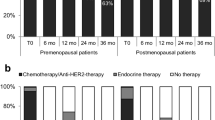Abstract
Purpose: The objective was to compare health related quality of life (QOL) in hormone receptor negative, node-positive breast cancer patients receiving adjuvant chemotherapy to determine whether a more intensive chemotherapy regimen has an adverse effect upon QOL that is not balanced by improvements in disease control or survival. Increased physical symptoms, including fatigue and the inconvenience of the dose intensive 16-week regimen, were expected to have a negative impact on QOL. Design: QOL was measured in 163 patients, randomized to either a standard cyclophosphamide, doxorubicin and 5-flurouracil (CAF) or a 16-week multidrug regimen, using the Breast Chemotherapy Questionnaire (BCQ). The 30 item BCQ was self-administered prior to therapy, during therapy, and 4 months post treatment. Results: BCQ scores decreased (worsened) more during therapy on the 16-week regimen, median change −1.4, than on CAF, median change −0.8 (p < 0.001). By 4 months post treatment, BCQ scores were higher than pre-treatment and equal in the two arms (CAF: 8.1 and 16 weeks: 8.2, p = 0.6). Over a period of 48 months, patients on the 16-week regimen averaged 1.4 fewer months of treatment with toxicity, 4.0 more months without symptoms and 0.7 fewer months post recurrence compared to patients on the CAF regimen. Given typical values for these health states, the gain in Q-TWiST observed for the CAF regimen during treatment shifted to the 16-week regimen after 1 year, with a gain of 2.0 to 2.4 months after 4 years. Conclusions: The hypothesized negative impact of the dose intensive 16-week regimen was confirmed by the BCQ assessments. However, Q-TWiST analysis suggests a small gain for the 16-week regimen. The later results should be interpreted with caution with the limited follow-up of 4 years.
Similar content being viewed by others
References
Fetting J, Gray R, Abelo. M, Fowble B, Smith T, Vail S, Durrani G, Eudey L, Henney J, Morgolin K, Citron M, Osborne D, Henderson C. CAF vs. a 16-week multidrug regimen as adjuvant therapy for receptor-negative, node positive breast cancer: An Intergroup study. Proc Am Soc Clin Oncol 1995; 114: 96 (#83).
Goldhirsch A, Gelber RD, Simes RJ, Glasziou P, Coates AS. Costs and bene®ts of adjuvant therapy in breast cancer: a quality adjusted survival analysis. J Clin Oncol 1989; 7: 36–44.
Gelber RD, Goldhirsch A, Cavalli F. Quality of Life Adjusted Evaluation of Adjuvant Therapies for Oper-able Breast Cancer. Annals of Internal Med 1991; 114: 621–628.
Gelber RD, Cole BF, Gelber S, Goldhirsch A. Comparing treatments using quality-adjusted survival: the Q-TWiST method. The Am Stat 1995; 49: 161- 169.
Moinpour C, Feigl P, Metch B, et al. Quality of Life endpoints in cancer clinical trails: Review and recom-mendations. JNCI 1989; 81: 485–495.
Levine M, Guyatt G, Gent M, DePauw S, Goodyear MD, Hryniuk WM, Arnold A, Findlay B, Skillings JR, Bramwell VH, Levin L, Bush H, Abu-Zahra H, Kotalik J. Quality of life in stage II breast cancer: An instrument for clinical trials. J Clin Oncol 1988; 6: 1798–1810.
Fetting JH, Gray R, Fairclough DL, Smith TJ, Margolin KA, Citron ML, Grove-Conrad M, Cella DL, Pandya K, Robert N, Henderson IC, Osborne CK, Abelo. MD. A 16-week Multidrug Regimen vs. cyclophosphamide, doxorubicin, and 5-Flurouracil (CAF) as Adjuvant Therapy for Node-Positive, Re-ceptor Negative Breast Cancer: An Intergroup Study. J Clin Oncol,1998; 16: 2382–2391.
Hollander M, Wolfe DA. Nonparametric Statistical Methods. NY: John Wiley and Sons, 1973: 50–52, 75–82.
Fairclough DF. Quality of Life in Cancer Clinical Trials: Now that we have the data, what do we do? J Appl Stat Sci 1996; 4: 253–269.
Weeks J. Personal communication, 1996.
O'Leary JF, Fairclough DL, Jankowski MK, Weeks JC. Comparison of Time-tradeo. Utilities and Rating Scale Values of Cancer Patients and their Relatives. Med Decis Making 1995; 15: 132–137.
Fetting J. Personal communication, 1997.
Hurny C, Bernhard J, Coates AS, Castigilione-Gertsch M, Peterson HF, Gelber RD, Forbes JF, Rudenstam CM, Simoncini E, Crivellari D, Goldhirsch A, Senn HJ. Impact of adjuvant therapy on quality of life in women with node-positive operable breast cancer. Lancet 1996; 347: 1279–1284.
Fairclough DL, Fetting J, Cella D, et al. Quality of Life on A Breast Cancer Adjuvant Trial Comparing CAF with a 16-week Regimen. Proc Am Soc Clin Oncol 1995; 114: (#890).
Smith TJ, Hilner BE. The effcient and cost-effectiveness of Adjuvant Therapy of Early Bresist Cancer in Premenopausal Women. J Clin Oncol 1993; 11: 771- 776.
Author information
Authors and Affiliations
Rights and permissions
About this article
Cite this article
Fairclough, D.L., Fetting, J.H., Cella, D. et al. Quality of life and quality adjusted survival for breast cancer patients receiving adjuvant therapy. Qual Life Res 8, 723–731 (1999). https://doi.org/10.1023/A:1008806828316
Issue Date:
DOI: https://doi.org/10.1023/A:1008806828316




